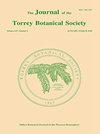Distribution of wetland tree species in relation to a flooding gradient and backwater versus streamside location in Arkansas, U.S.A.1
IF 0.8
4区 生物学
Q4 PLANT SCIENCES
引用次数: 9
Abstract
DALE, EDWARD E., JR. (Dept. of Biological Sciences, University of Arkansas, Fayetteville, AR 72601) and STEWART WARE (Dept. of Biology, College of William and Mary, Williamsburg, VA 23187-8795). Distribution of wetland tree species in relation to a flooding gradient and backwater versus streamside location in Arkansas, U.S.A. J. Torrey Bot. Soc. 131: 177-186. 2004.-Most of Arkansas is outside the normal geographic range of several bottomland hardwood species important in floodplain forests of the southeastern United States. Other species therefore occupy the portions of the flooding gradient normally filled by those missing species. Analysis of 45 non-quantitative elevational transects from slough edge or stream edge to upland sites and ordination of 58 quantitatively sampled bottomland stands were used to assess distribution of tree species along a flooding gradient and in relation to steamside vs. backwater habitats in southern and eastern Arkansas. Emphasis was on hardwood stands dominated by species other than the extremely flood-tolerant Taxodium distichum and streamside species Salix nigra. Flooding gradient rankings based on site dominance along the elevational transects could be assigned to 20 tree species. Across the ordination, three dominant oaks were arranged from drier to wetter sites in the order Quercus nigra, Q. phellos, and Q. lyrata. Despite a wide moisture tolerance, Liquidambar styraciflua was much more important toward the drier end of the ordination. Carya ovata was important in much wetter stands than would be predicted by the literature, and Quercus stellata and Q. texana (= Q. nuttallii) were most important near the middle rather than at the drier end of the ordination. Carya aquatica was the important hickory in the wetter half of the ordination, and occurred in both backwater and streamside stands. Celtis laevigata also reached high importance in both streamside and backwater sites, and its associates in those sites suggest that it has greater flood tolerance than indicated by the elevational transects. Taxa like Forestiera acuminata and Planera aquatica that typically occur as subcanopy species were dominant in some wet stands, presumably because timber harvest had removed most of the original canopy trees. Ulmus spp. and Fraxinus pennsylvanica occurred at moderate levels across all but the driest portion of the flooding gradient, but almost never dominated a stand, and surprisingly were rarely important in the same stands. The important southern bottomland forest species Quercus laurifolia, Fraxinus caroliniana, F. profunda, and Nyssa sylvatica var. biflora (= N. biflora) are among those absent from the study area, and several other such species were present but of very low importance (Quercus michauxii, Acer rubrum, Acer saccharinum, Betula nigra).美国阿肯色湿地树种分布与洪水梯度、回水和河边位置的关系
DALE, EDWARD E., JR.(阿肯色大学生物科学系,费耶特维尔,阿肯色州72601)和STEWART WARE(威廉玛丽学院生物系,威廉斯堡,弗吉尼亚州23187-8795)。美国阿肯色湿地树种分布与洪水梯度、回水和滨水位置的关系。《社会科学》131:177-186。2004.阿肯色州的大部分地区不在美国东南部洪泛区森林中几种重要的低地硬木的正常地理范围之内。因此,其他物种占据了通常由那些消失物种填充的洪水梯度部分。通过对45个从沼泽边缘或溪流边缘到高地的非定量海拔样带的分析,以及58个定量采样的洼地林分的排序,评估了阿肯色州南部和东部沿洪水梯度的树种分布,以及与蒸汽边和回水栖息地的关系。重点是硬木林分,除极耐涝的紫杉(Taxodium distichum)和河边种黑柳(Salix nigra)外,其他树种占主导地位。基于站点优势度沿海拔样带的洪水梯度排序可分配给20种树种。在整个排序中,三种优势栎树从干燥地到湿润地依次为黑栎、黑栎和黑栎。尽管具有广泛的耐湿性,但在排序的干燥端,Liquidambar styraciflua更为重要。山核桃(Carya ovata)在比文献预测的更湿润的林分中占有重要地位,而栎(Quercus stellata)和德克萨斯栎(Q. texana)在接近林分中部的林分中占有最重要的地位。水山核桃(Carya aquatica)是该群落湿区重要的山核桃,在回水林分和滨水林分均有分布。在河滨和回水地区,Celtis laevigata的重要性也很高,其在这些地区的关联表明,它比海拔样带所显示的具有更大的耐洪能力。在一些潮湿的林分中,典型的亚冠物种如针叶森林(foretiera acuminata)和水生平原(Planera aquatica)在一些湿林分中占主导地位,可能是因为木材采伐已经移除了大部分原始冠层树木。榆木(Ulmus spp.)和宾夕法尼亚白曲霉(Fraxinus pennsylvania)在除最干燥部分外的所有洪水梯度中都有中等水平的分布,但几乎从未在一个林分中占主导地位,令人惊讶的是,在同一林分中很少重要。南方滩地森林的重要树种有松柏、卡罗莱纳白曲树、深叶栎和双花木,但在研究区未发现,其他一些重要树种(栎、红槭、糖槭、黑桦树)也有,但重要性很低。
本文章由计算机程序翻译,如有差异,请以英文原文为准。
求助全文
约1分钟内获得全文
求助全文
来源期刊
CiteScore
0.70
自引率
0.00%
发文量
16
审稿时长
>12 weeks
期刊介绍:
The Journal of the Torrey Botanical Society (until 1997 the Bulletin of the Torrey Botanical Club), the oldest botanical journal in the Americas, has as its primary goal the dissemination of scientific knowledge about plants (including thallopyhtes and fungi). It publishes basic research in all areas of plant biology, except horticulture, with an emphasis on research done in, and about plants of, the Western Hemisphere.

 求助内容:
求助内容: 应助结果提醒方式:
应助结果提醒方式:


